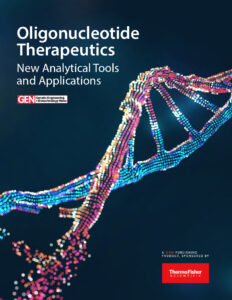RNA therapeutics comprise a rapidly expanding category of drugs that will change the standard of care for many diseases and actualize personalized medicine. These drugs are cost effective, relatively simple to manufacture, and can target previously undruggable pathways.
Oligonucleotide therapies include short, single- or double-stranded DNA, or RNA molecules that bind via Watson-Crick base pairing to enhance or repress the expression of target RNA to treat or manage a wide range of diseases. They include antisense oligonucleotides (ASOs), RNA interference (RNAi), and aptamers.
In general, oligonucleotide therapeutics interfere or inhibit the RNA translational process within the cell and promote degradation of proteins associated with disease.
Oligonucleotide therapeutics development and manufacture requires confirmation of the correct nucleic acid sequence and comprehensive characterization and quantification of impurities to ensure therapeutic efficacy. In the later stages of development, this must be done in accordance with strict regulatory guidance. Presently, the guidelines themselves are evolving. The main challenge is presented by the complexity of the oligonucleotide molecules themselves and the modifications that are being applied to them.
Chemical modifications have been utilized extensively to improve the binding energy, stability, and tolerability of oligonucleotide therapeutics, including ASOs, small interfering siRNAs, and aptamers. Phosphorothioate modifications, which incorporate sulfur in the oligo backbone, have been effective due to their ability to enhance cellular uptake and evade nuclease-mediated degradation in serum.
Chemical modification continues to evolve and bring more drug-like properties to oligonucleotide therapeutics. These include sugar and base modification and/or conjugated molecules that improve target delivery. Next-generation analytical solutions from Thermo Fisher Scientific are evolving, too. Our chromatography and mass spectrometry solutions allow you to rapidly characterize and quantify components of your oligonucleotide therapeutics with greater clarity and accelerate the progression to market.





Comments are closed.